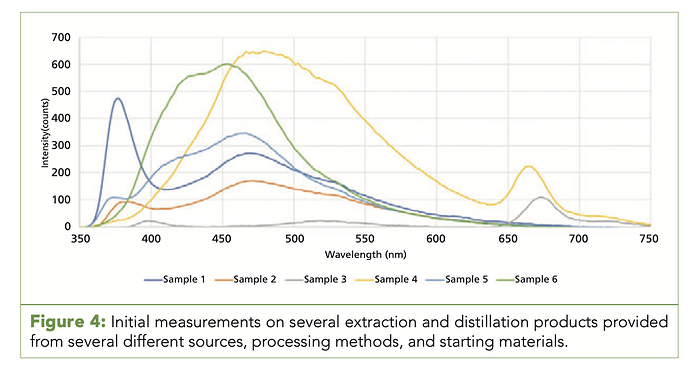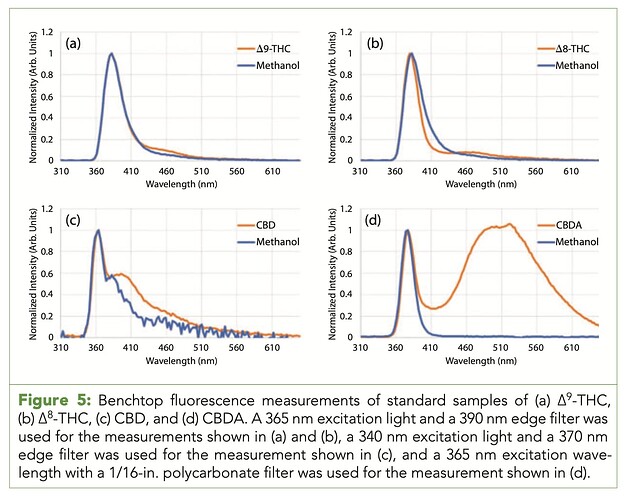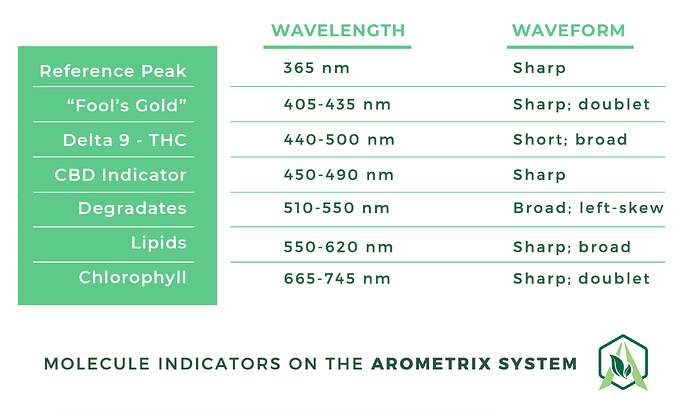In 2017 Tim called me and asked if I could provide the wavelength we were testing THC at in our HPLC. We talked back and forth a bit and a group of his engineers showed up at Summit a few weeks later with an R&D spectrometer. We tested distillate samples dissolved in ethanol. I actually did a lot of the dilutions myself. By 2018 they had a fraction finder product to test on a short path that was similar to what they are using now.
That research all eventually resulted in this paper which was released September/October 2019:
In-Situ-Fluorescence-Spectroscopy.pdf (548.8 KB)
The engineers (not chemists) are the authors of this paper, Kenneth and Chris. At the time of releasing this paper they were just exploring the underlying technology (fluorescence spectrometry) and checking if it’s useful in cannabis processing. This is R&D I found very cool and so I participated. The claims got out of hand and I stepped way back when I couldn’t sway the company.
This chart shows the fluorescent peaks we found in extracts dissolved in ethanol 10:1: Arometrix writes “These samples were tested to broadly investigate the diversity of the fluorescence response from different quality extract and distillate samples and to investigate any overall trends in these responses with respect to sample type. More rigorous studies on composition and fluorescence will be the focus of future work.” I’m trying to find where that future research is published.
This chart shows the fluorescent peaks found in some liquid standard samples at a concentration of 1mg/mL. Arometrix writes that " It should be noted that within the resolution of the spectroscopic measurements, ∆8-THC and ∆9-THC show very similar responses with respect to peak position and shape. This indicates that the investigated fluorescence measurement at the 365 nm excitation wavelength may not be able to distinguish between ∆8-THC and ∆9-THC in a sample, but instead can be used to detect the presence of total THC molecules." Already Arometrix is taking a step too far here.
To say that this peak “can be” used to detect the presence of THC at 1mg/mL is a serious claim to make. Everyone should hold ourselves to a higher standard than to take one single result from a liquid standard and extrapolate such a serious claim. The proper thing to say here if there isn’t further investigation in this paper is to say “could be” rather than “can be”. This is an early liberty they took with the science. This may seem small but it’s central to the success of the misdirection. When someone wants to buy the sensor of course it “can be” used to detect d9. Soon the unsuspecting client realizes that the sensor only “could be” used for THC detection and in almost all cases it can’t be used for it at all.
In this chart at 365nm excitation a tiny amount of blue light (400nm) was detected in a sample containing 1mg/mL d9 dissolved in methanol. That means the lower end of detection for this setup is 1g/L. When dissolving crystalline cannabinoids at those concentrations and exciting at 365nm, no blue light is produced. However, when dissolving mother liquor, where less cannabinoids are, a huge response is present. Find that info here: Fraction Finder Reviews - #176 by AlexSiegel. This shows that using solid samples does not produce the same results as their liquid standards, which should have warranted a major rehab in their R&D. All I have heard from their team since brining it to their attention in 2019 (I think) is denials, insults, and accusations.
Arometrix continues “Finally, the in-situ measurements showed the presence of the same peaks (this peak is simply blue light. Many things produce blue light at 365nm. This is another liberty) that were present during the measurement of the chemical standards and provided a proof of concept (lol) for the use of fluorescence spectroscopy as a control system for cannabis distillation… Future work will include determination of the specific fluorescing chemical constituents, improving the sensitivity and accuracy of the in-situ system, extending the technique to include extraction and wiped film distillation systems, and integration of the technique into an SPD control system for automated process control.”
Somewhere along the line Arometrix decided to go ahead and market the sensor to its customers using D9 detection as the central selling point even though none of their own underlying research directly supports that claim.
Yet here we are. Companies that support this sensor are only feeding the lie and have a responsibility to their customers to objectively look at if this is something they want to support.


